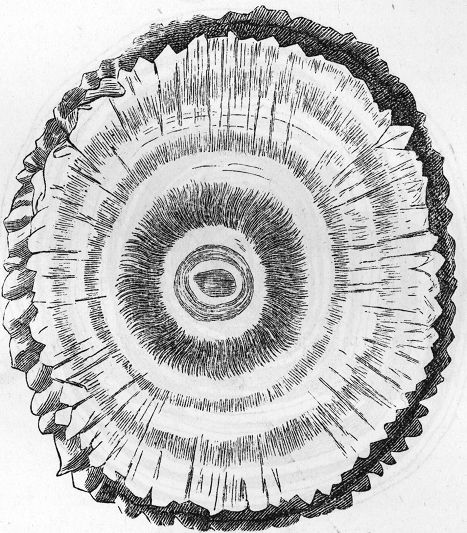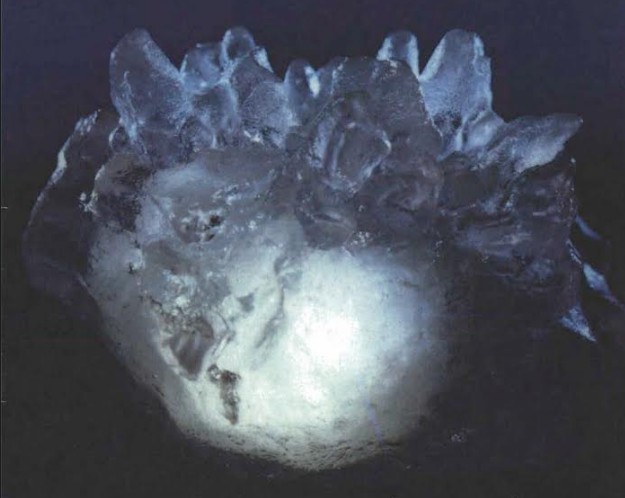Hail is a type of precipitation that consists of ice, often as a whitish pea sized rounded "stone". Hail is formed in certain clouds with strong vertical movements inside. When water particles in the cloud are carried upward by strong winds, they are turned to solid ice when reaching the colder upper part of the cloud. When moved sideways the ice particles are taken by winds of downward direction and melt a little at the surface in the wind until upward winds lift them again. The skin of water from below is frozen to a new ice layer in the fattening hailstone. The more trips in the cloudlift, the more concentric ice layers in the hailstone.
Finally gravity takes over and a shower of hailstones start falling, bombarding everything on the earth's surface. The final speed of a 10 mm hailstone is about 50 km/h, but a heavier 50 mm hailstone hits an object at 110 km/h. Small hailstones can defoliate trees and plants and annihilate a corn field. Golf ball sized hailstones kill big animals and people. When Charles Darwin left the Beagle during his circumnavigation of the world and on horseback approached Buenos Aires 16 September 1833, he stopped at a hacienda for the night and learned that hailfalls can be dangerous. The farm people were busy repairing the hail damage of a thunderstorm that afternoon. Large numbers of small animals — most of them birds — lay dead everywhere between the hailstones. 20 thick skulled deer had been beaten to death. The ostriches which had survived wandered around in the area aimless. Apple sized hailstones had made them one-eyed. Darwin realized the importance of what he saw.

When a hailstone is cut in two halves, its history of growth is conspicuous due to dense ice layers formed when the wind carried it upwards to colder levels in the cloud, and porous "snowy" layers when the ice thawed during its fall downwards.
Hail storms can occur everywhere but are more common in some areas and countries. China, India, South Africa suffer badly, but high-income countries such as the USA and some European nations suffer tremendous financial losses by hailstorms hitting densely populated areas. On 12 July 1984 Munich in Germany was bombarded during 28 minutes causing damages of 5.7 billion USD. 240,000 cars got plate injuries, 200 aircraft including a Boeing 757 were damaged, 70,000 house roofs were also damaged. People had been warned, noone was killed.

Photo courtesy Munich RE 1984. This record hailstone weighed 770 gram and was 14 cm wide when it fell at Coffeeville in Kansas, USA, on 3 September 1970. This is a cast of the actual hailstone.
In the mountainous parts of China and a few other countries where hailstorms are common, hailstones of remarkable size have been recorded. Very big hailstones are not always rounded and concentrically built but show faces of large ice crystals. Such big and strangely shaped masses of ice falling from the sky are often called cryometeorites. We know them from written documents throughout history. Some people think these phenomena are getting more frequent, but there is no indication of this — rather the number of observing eyes has grown. At the beginning of the Common Era, that is at AD 1, the human population was about 10 million. When this is written there are 7,640 million people. Furthermore, today we have a great number of sophisticated instruments that help us see more.
| HAIL subregister (pages) | 90 |
| General | 6 |
| Asia | 9 |
| China | 2 |
| India | 1 |
| Israel-Palestine | 1 |
| Japan | 2 |
| Near Middle East | 1 |
| Syria | 1 |
| Thailand | 1 |
| Europe | 73 |
| Armenia | 1 |
| Austria | 1 |
| Belgium | 1 |
| Czechia | 1 |
| Denmark | 5 |
| Europe | 7 |
| Finland | 2 |
| France | 5 |
| Germany | 13 |
| Hungary | 1 |
| Ireland | 1 |
| Italy | 2 |
| Netherlands | 2 |
| Norway | 1 |
| Poland | 1 |
| Romania | 1 |
| Russia | 1 |
| Scotland | 1 |
| Spain | 2 |
| Sweden | 14 |
| Switzerland | 2 |
| Turkey | 4 |
| England+Wales | 4 |
| Africa | 2 |
| Egypt | 1 |
| Nigeria | 1 |
| North America | 5 |
| Canada | 1 |
| Mexico | 3 |
| USA | 1 |
| Australia | 1 |